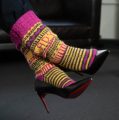I was sitting in a café, half-lost in my coffee, when a man at the next table started explaining why women shouldn’t be in decision-making roles.
“Too emotional,” he said, matter-of-factly, like it was the most obvious truth in the world.
I didn’t interrupt. I didn’t argue. Didn’t have the energy to do that at that moment. All I thought was, ‘I hope he doesn’t have daughters or granddaughters.’ Because if he does, they’re growing up with someone who should be their biggest supporter, but who’s already decided they’re not capable. That isn’t just opinion; it’s a weight. A ceiling built into their own home.
And then the universe seemed to weigh in. Outside the café, a bus tyre exploded with a crack, like a gunshot. Both men ducked instantly, startled, visibly shaken. I almost burst into laughter, trying to keep it cool, drinking my coffee.
One of them muttered, half-laughing, “The moment we started talking about Muslims, it exploded.” It struck me how quickly bias spills from one group to another. Women, Muslims, anyone seen as “different”. Their nerves betrayed them, even as they joked.
These were the same men who, only minutes earlier, claimed that women are too sensitive, too emotional, to lead. Emotionality isn’t gendered; it’s human. The real difference lies in how we channel it.
What is emotion?
Let’s start from the beginning. An emotion is a complex psychological and physiological state characterised by subjective feelings, bodily changes, expressive behaviours, and cognitive appraisals in response to internal or external stimuli.
In simpler terms:
- It’s how we feel (like happiness, fear, anger, sadness).
- It involves changes in the body (heart rate, hormones, facial expressions).
- It influences our thoughts, decisions, and actions.
Emotions serve important functions: they help humans respond adaptively to our environment, communicate with others, and guide their behaviour.
And you can’t be completely immune to emotions, because they’re deeply tied to how the human brain and body work. Emotions evolved as survival mechanisms: fear helps us detect dangers, joy reinforces rewarding behaviours, anger defends boundaries, sadness signals loss and draws support, and so on.
That said, people differ in how strongly and how often they feel emotions, and there are conditions or practices that can reduce their intensity. So while you can’t fully escape emotions, you can change how you experience, regulate, and express them.
What the Data Really Says About Women in Leadership
The strange thing is, research tells a very different story. Companies with more women in leadership are significantly more profitable, innovative, and resilient. A global review found female leadership boosts not only financial outcomes but also risk management and firm stability. Boards with women make better, more robust, and more creative decisions and are less prone to blind spots.
Organisations led by women report greater productivity, collaboration, and fairness, according to the American Psychological Association. And one major study found that increasing female representation in leadership to 30% was linked with a 15% jump in profitability.
In other words, the evidence is clear. Female decision-makers don’t weaken systems. They strengthen them.
Decision-making itself doesn’t belong to one gender. Women often bring a collaborative, interpersonally oriented style, seeking input and building consensus. That’s not a weakness. That’s strategy. Empathy, so often dismissed as “soft”, is one of the hardest, sharpest tools we have. In negotiation, it’s called tactical empathy: the skill of reading the room, anticipating needs, and aligning people toward a shared goal.
And yet stereotypes persist. Role congruity theory shows how women are punished either way: be warm and you’re seen as incapable; be assertive and you’re called unlikable. Considering the everyday authority gap, where women are interrupted, questioned, or overlooked more than men, it’s no wonder that so many women still have to fight just to stand in positions they already deserve.
Breaking the Ceiling: Progress, Setbacks, and the Way Forward
I’ve worked in male-dominated fields and sectors my whole life. I’ve been called “girl” in rooms where everyone else had a title. I’ve been dismissed before I even spoke. I’ve also been treated as an equal, trusted with responsibility, and valued for my perspective.
Those contrasts have shaped how I see gender and leadership. The progress is real, but so are the setbacks. For every space where women are welcomed as decision-makers, there’s still another where bias lingers quietly in the background or out loud at the next café table.
But here’s what I held onto as I listened to that man: the world is changing. His words, as heavy as they sounded, are not the future. The girls and young women who are growing up today will become leaders regardless of the current situation. They’ll rise above outdated judgements and bring empathy, intelligence, and strength to the tables that once excluded them.
Women don’t need a permission to lead
And maybe one day, someone will overhear a story like his in a café, not as a warning, but as a reminder of how far we’ve come. Proof that prejudice can’t hold when reality keeps proving otherwise. That’s why, at home, I want to teach the young men in my life that equality is non-negotiable, empathy is strength, and difference is not something to fear but something that makes us stronger.




